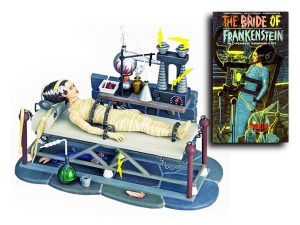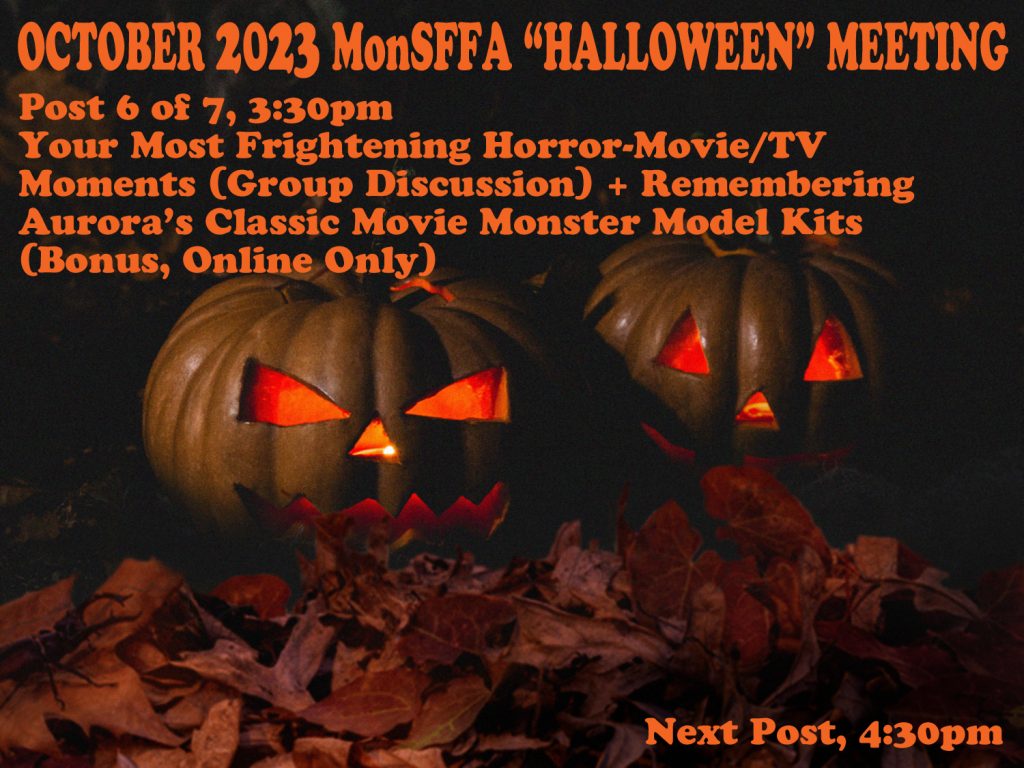10) Group Discussion: Your Most Frightening Horror-Movie/TV Moments!
This afternoon, we’re asking “Which are your most frightening horror-movie/TV moments?”
Hitchcock’s birds gathering in the school playground, or his famous shower scene; the alien violently bursting through Kane’s chest; little Danny encountering the ghosts of those creepy twin girls in the empty corridors of the Overlook; The scream-stripping “Gentlemen” arriving in Sunnydale to carry out their ghoulish objectives…
Or perhaps you like your screen horror old-school—the unmasking of the Phantom of the Opera or the mummy Imhotep rising from the dead, causing archeologist Sir Joseph Whemple’s hapless assistant, Norton, to descend into madness!
The floor is open. Don’t be afraid to share with the group your most frightening horror-movie/TV moments!
After our discussion, scroll down a little for more bonus content; learn about Aurora’s line of classic movie monster model kits. We originally featured this article during our 2020 virtual Halloween meeting, back when COVID-19 was something of an unknown quantity and running rampant, and there was not yet a vaccine. Scary times! So much so that Montreal authorities “cancelled” Trick-or-Treating!
This afternoon’s e-meeting is a continuing experiment. If the local technology is performing properly and all has gone well, you are viewing a live-stream of this “Halloween” MonSFFA meeting, now underway. Those joining us online may follow along, and participate, by way of our ZOOM-chat.
Are you able to clearly see and hear today’s meeting? We are testing various set-ups to ascertain which delivers the best results for our online participants. Please take a moment to leave a comment as to how well this live-stream/ZOOM-chat is working from your perspective. It is our aim to live-stream future club meetings, thereby creating hybrid events in which participation may take place both in-person and virtually.
11)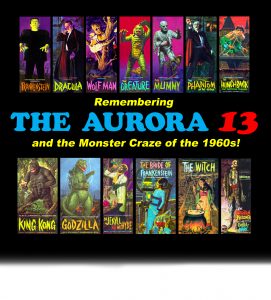
Any so-called “Monster Kid” growing up in the 1960s harboured two utmost desires: the latest issue of Famous Monsters of Filmland magazine (co-founded by pioneering sci-fi fan Forrest J Ackerman), and the latest release in Aurora’s line of classic monster model kits!
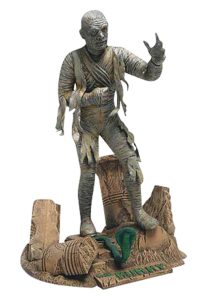 The Long Island, NY-based Aurora Plastics Corporation was founded in 1950 as a contract manufacturer of injection-molded plastics. Before too long, the company began producing and marketing its own line of “all plastic assembly kits” for young hobbyists, focusing chiefly on aircraft and automobiles.
The Long Island, NY-based Aurora Plastics Corporation was founded in 1950 as a contract manufacturer of injection-molded plastics. Before too long, the company began producing and marketing its own line of “all plastic assembly kits” for young hobbyists, focusing chiefly on aircraft and automobiles.
Aurora’s first figure kits, a set of medieval knights in armour, were introduced in the mid-’50s, quickly followed by the “Guys and Gals of All Nations” series, featuring statuettes dressed in the national costumes of Holland, China, Scotland, and other countries, this in an effort to appeal to female crafters. Throughout the late-’50s, ’60s, and ’70s, other historical subjects followed the knights, from Roman gladiators to modern U.S. soldiers, sailors, and airmen, along with a variety of kits spotlighting American wildlife, sports stars, comic book superheroes, sci-fi TV characters, and the prehistoric world.
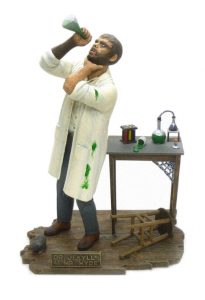 But it was a licensing agreement with Universal Studios that allowed Aurora to launch what would become its most popular and successful series of all, the Movie Monster Models collection!
But it was a licensing agreement with Universal Studios that allowed Aurora to launch what would become its most popular and successful series of all, the Movie Monster Models collection!
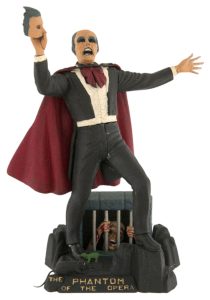
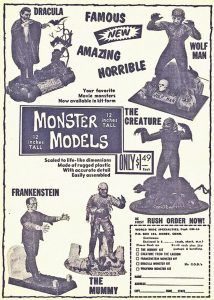 Universal’s classic horror films were enjoying a revival in the late-’50s-early-’60s and were all the rage with youngsters, who watched them on television, where they aired frequently, or flocked to movie houses to see them. Aurora marketing director Bill Silverstein had taken note of the appeal these old pictures had with adolescents and teens, and pitched the idea of a series of kits showcasing Universal’s stable of venerable movie monsters. He was met with ridicule and disinterest but persisted and eventually convinced skeptical upper management to gauge interest by bringing to market one model.
Universal’s classic horror films were enjoying a revival in the late-’50s-early-’60s and were all the rage with youngsters, who watched them on television, where they aired frequently, or flocked to movie houses to see them. Aurora marketing director Bill Silverstein had taken note of the appeal these old pictures had with adolescents and teens, and pitched the idea of a series of kits showcasing Universal’s stable of venerable movie monsters. He was met with ridicule and disinterest but persisted and eventually convinced skeptical upper management to gauge interest by bringing to market one model.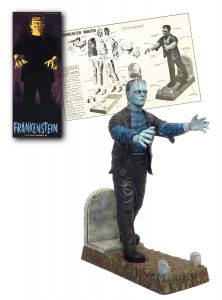
That model was Frankenstein, released in 1961. Silverstein was soon vindicated! Frankenstein was an instant hit and calls started coming in to Aurora’s sales offices requesting other kits in the line. Dracula and The Wolf Man were rushed into production and were on store shelves in time for Christmas 1962. The Creature (from the Black Lagoon), The Mummy, The Phantom of the Opera, Dr. Jekyll as Mr. Hyde, non-Universal behemoths King Kong and Godzilla, and others followed. There were 13 monster kits produced in all—tagged by aficionados “The Aurora 13”—plus two customizing kits and a Gigantic Frankenstein, the finished model standing some two-feet tall. A pair of affiliated models, the Munsters ’65 and the Addams Family Haunted House, are often considered part of the series.
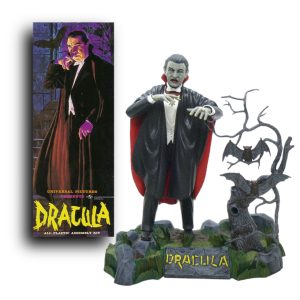
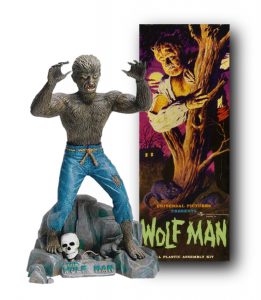 Advertised in Famous Monsters of Filmland and DC Comics publications, Aurora’s monster kits skyrocketed in popularity. In 1964, a U.S.-wide Monster Customizing Contest was sponsored in cooperation with Universal Pictures and Famous Monsters, contributing to a growing “Monster Mania.”
Advertised in Famous Monsters of Filmland and DC Comics publications, Aurora’s monster kits skyrocketed in popularity. In 1964, a U.S.-wide Monster Customizing Contest was sponsored in cooperation with Universal Pictures and Famous Monsters, contributing to a growing “Monster Mania.” 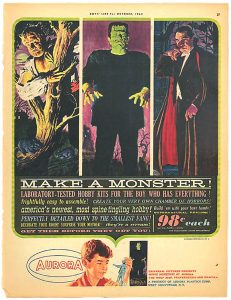 Young model-makers were tasked with creating a macabre diorama using any combination of Aurora monster kits and customizing materials. Two customizing kits were issued, providing modellers with an assortment of skulls, spiders, rats, and such with which to enhance their miniature tableaus. Each entrant received a “Master Monster Maker” certificate. Hundreds of prizes were handed out with the national winner awarded a paid trip to Hollywood and the opportunity to appear in a horror movie!
Young model-makers were tasked with creating a macabre diorama using any combination of Aurora monster kits and customizing materials. Two customizing kits were issued, providing modellers with an assortment of skulls, spiders, rats, and such with which to enhance their miniature tableaus. Each entrant received a “Master Monster Maker” certificate. Hundreds of prizes were handed out with the national winner awarded a paid trip to Hollywood and the opportunity to appear in a horror movie!
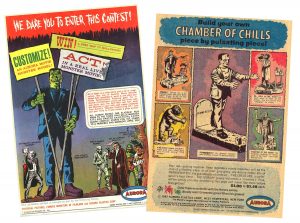
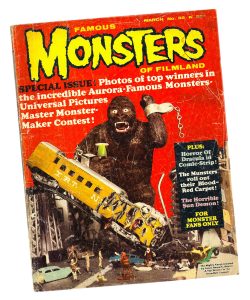 Sculptor Bill Lemon was responsible for designing and producing the patterns for most of the monster models, with Ray Meyers and Adam “Larry” Ehling taking over when Lemon left to pursue other commissions.
Sculptor Bill Lemon was responsible for designing and producing the patterns for most of the monster models, with Ray Meyers and Adam “Larry” Ehling taking over when Lemon left to pursue other commissions. 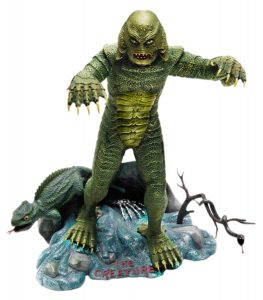 The Forgotten Prisoner of Castel-Mare was the last kit in the line, becoming available in 1967-’68 and sporting box art by renowned pulp illustrator Mort Künstler.
The Forgotten Prisoner of Castel-Mare was the last kit in the line, becoming available in 1967-’68 and sporting box art by renowned pulp illustrator Mort Künstler.
It was the box art produced by James Bama, however, that indelibly marked Aurora’s Movie Monster Models. At the time, Bama was working as a commercial artist for a major New York advertising firm. He was known as a prolific paperback and magazine cover artist, as well as for dramatic interior illustrations featured in men’s adventure magazines. Genre fans would soon come to know him for his extraordinarily striking monochromatic Doc Savage covers for Bantam Books’ paperback reprints of the original novels.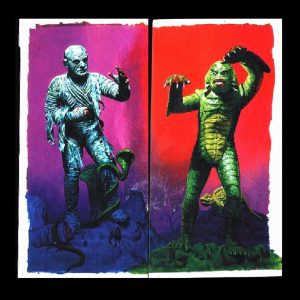
The accomplished illustrator applied his signature realism to what was fantastical subject matter in rendering melodramatically lit, vividly colourful box art for the monster kits. 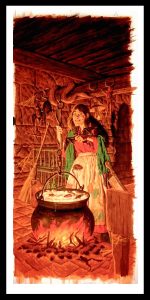 Save for Künstler’s single contribution, Bama produced all of the original box art for the series, as well as a few pieces for spin-offs like the Monstermobiles line, which put our favourite monsters in crazily-exaggerated hot-rods, a concept that did not fly with either monster or hot-rod enthusiasts.
Save for Künstler’s single contribution, Bama produced all of the original box art for the series, as well as a few pieces for spin-offs like the Monstermobiles line, which put our favourite monsters in crazily-exaggerated hot-rods, a concept that did not fly with either monster or hot-rod enthusiasts.
Beginning in 1969, the original monster models were modified to include luminescent parts and reissued through the early-’70s with reworked packaging that included some new art by artist Harry Schaare, who essentially copied Bama’s originals while highlighting with bright acrylics the glow-in-the-dark components of the model. In some instances, Bama’s original gouache paintings were actually painted over with acrylics—no one present back in the day seems to know who might have been responsible for that sin, or perhaps nobody wants to say!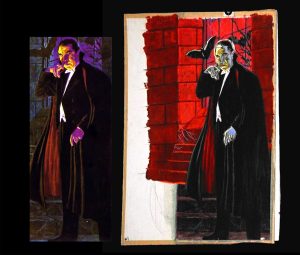
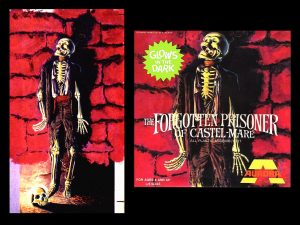
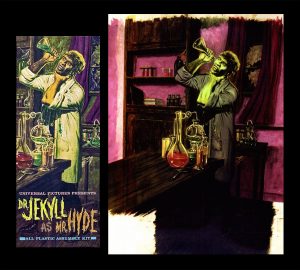
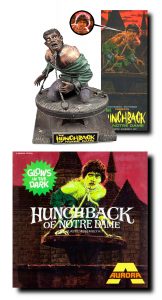
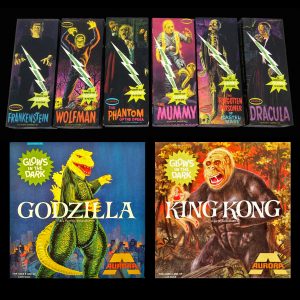
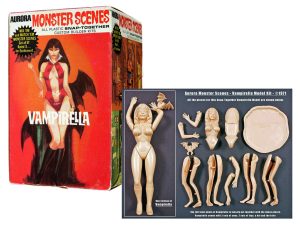 In 1971, Aurora launched its controversial Monster Scenes line, featuring four character kits: Frankenstein, sexy comic book pin-up Vampirella, the sadistic Doctor Deadly, and a scantily-clad young woman dubbed simply “The Victim.” At about 1/13 scale, these simple, snap-together, toy-like figures were smaller and lacked the detail of their movie monster cousins. The concept, here, was to enable children to easily assemble and then play with the models. Each figure came with extra sets of movable arms and legs so that they could be assembled in different poses
In 1971, Aurora launched its controversial Monster Scenes line, featuring four character kits: Frankenstein, sexy comic book pin-up Vampirella, the sadistic Doctor Deadly, and a scantily-clad young woman dubbed simply “The Victim.” At about 1/13 scale, these simple, snap-together, toy-like figures were smaller and lacked the detail of their movie monster cousins. The concept, here, was to enable children to easily assemble and then play with the models. Each figure came with extra sets of movable arms and legs so that they could be assembled in different poses
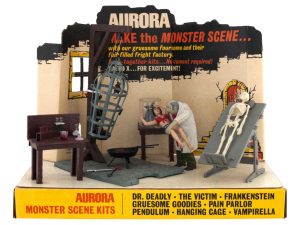 In addition to the character kits, four “grisly equipment” kits with names like Gruesome Goodies and The Pain Parlour were available, together serving as a torture-chamber playset into which the figures could be placed. Aurora played up the lurid horror, violence, and sex, promoting its new line with the slogan “Rated ‘X’ for excitement!”
In addition to the character kits, four “grisly equipment” kits with names like Gruesome Goodies and The Pain Parlour were available, together serving as a torture-chamber playset into which the figures could be placed. Aurora played up the lurid horror, violence, and sex, promoting its new line with the slogan “Rated ‘X’ for excitement!”
It wasn’t long before concerned parents were petitioning Nabisco, owners of Aurora at the time, outraged at these “sick toys” that make for a “sick society!” Women’s groups, too, admonished the company for promoting misogynistic cruelty, noting that the helpless “Victim” didn’t even rate her own name!
Nervous Nabisco quickly ordered a halt to the tooling on two new kits, a dungeon and an animal pit into which The Victim could be lowered, and announced that the Monster Scenes line was to be discontinued. Preliminary development on models of a second victim, an executioner, and more torture devices ceased. All remaining inventory, including three as yet unreleased kits—Dracula, Dr. Jekyll and Mr. Hyde, and The Giant Insect—were shipped to Canada, where The Victim was recast as Dr. Deadly’s Daughter.
The following year, Aurora recovered from this costly debacle, premiering its well-received Prehistoric Scenes line, which incorporated the same models-as-toys idea that had underpinned the short-lived Monster Scenes series.
Aurora’s swansong monster series was the 1/12-scale Monsters of the Movies line. But by now the monster craze had passed and the last kit in this series was shipped in 1977. The company shut down its molding machines that same year.
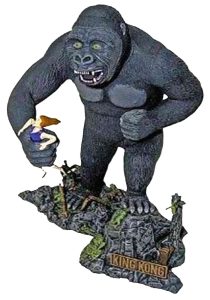 In a span of just 27 years, Aurora had progressed from humble beginnings to become one of the foremost and most innovative producers of scale-model kits in the industry, only to fall victim to a number of questionable marketing moves and product choices, as well as generally waning public interest in the hobby.
In a span of just 27 years, Aurora had progressed from humble beginnings to become one of the foremost and most innovative producers of scale-model kits in the industry, only to fall victim to a number of questionable marketing moves and product choices, as well as generally waning public interest in the hobby.
Bill Silverstein remained focused on the business of marketing toys. His stint at Aurora led him to join comic actors Don “Maxwell Smart” Adams and Bill “José Jiménez” Dana in forming a small advertising agency, securing Aurora as a client, of course! In the early-’70s, he became a partner at Helfgott & Partners (later Helfgott, Towne & Silverstein), a high-profile New York agency that represented the Ideal Toy Company.
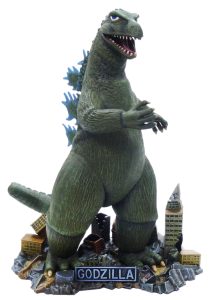 After leaving Aurora, Bill Lemon went on to sculpt for major toy manufacturers like Remco and Marx and produced, over his decades-long career, everything from anatomical models for medical schools to Pez dispensers to a circa-1980s Michael Jackson doll.
After leaving Aurora, Bill Lemon went on to sculpt for major toy manufacturers like Remco and Marx and produced, over his decades-long career, everything from anatomical models for medical schools to Pez dispensers to a circa-1980s Michael Jackson doll.
James Bama left New York in 1968 and moved to Wyoming, where he established himself as a painter specializing in Western themes. In recognition of his Aurora box art, he was inducted into the Monster Kid Hall of Fame in 2006.
Rival model manufacturer Monogram (later merged with another rival, Revell) initially acquired many of Aurora’s molds from parent company Nabisco and reissued a number of the kits under its own banner beginning in the late-’70s. In the mid-’90s and more recently, modern scale-model manufacturers like Polar Lights and Moebius Models have retooled, updated, and rereleased many of Aurora’s most popular kits, occasioning a revival of Monster Mania for both aging Monster Kids and a new generation.